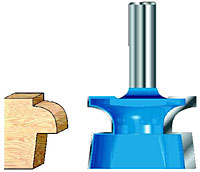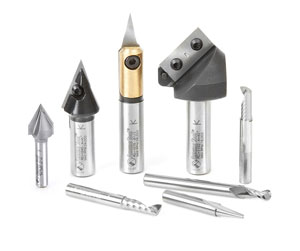Can you use router bits in a shaper? If you’ve ever wondered about this woodworking question, you’ve come to the right place! In this article, we’ll explore the compatibility of router bits and shapers, and uncover the possibilities they offer for your woodworking projects. So, let’s dive in and find out if these tools can work together to enhance your woodworking skills!
When it comes to woodworking, having the right tools can make all the difference. And that’s where router bits and shapers come into play. While both tools have their unique functions, many woodworkers often wonder if they can interchangeably use router bits in a shaper. So, let’s unravel this mystery and see if it’s possible!
Router bits are versatile cutting tools commonly used with routers to shape and trim various materials. On the other hand, shapers are woodworking machines designed specifically for profiling and molding edges, making them ideal for larger-scale projects. But can you use router bits in a shaper? Let’s find out more in the following paragraphs!

Can You Use Router Bits in a Shaper? Exploring the Possibilities
Understanding the Basics of Router Bits and Shapers
Router bits and shapers are both versatile tools used in woodworking. Router bits are designed to work with handheld routers, while shapers are stationary machines specifically built for shaping wood. While there are similarities between the two, it’s important to understand the key differences.
Router bits typically have 1/4-inch, 1/2-inch, or 8mm shank sizes, allowing them to be used with handheld routers. They come in a wide range of shapes and sizes, each intended for a specific woodworking task. On the other hand, shapers have larger and more powerful motors, allowing them to handle heavier workloads and larger diameter cutter heads. Shapers often have 1/2-inch or 3/4-inch spindles and can accommodate a variety of cutter heads.
Now that we have a basic understanding of router bits and shapers, let’s delve into the question at hand: can you use router bits in a shaper?
Exploring the Possibilities: Using Router Bits in a Shaper
The short answer is yes, you can use router bits in a shaper with the right accessories and safety precautions. Many shapers come with an adapter that allows you to use router bits, expanding the range of possibilities for your woodworking projects. However, it’s essential to follow the manufacturer’s guidelines and ensure that your shaper is compatible with router bits before attempting to use them.
When using router bits in a shaper, there are a few things to keep in mind. Firstly, make sure to use a collet or adapter that matches the shank size of the router bit. This ensures a secure fit and minimizes the risk of accidents. Additionally, always make sure that the spindle speed of your shaper is appropriate for the router bit you are using. Running a router bit at a higher speed than recommended can cause the bit to heat up and potentially break.
It’s also worth noting that although router bits can be used in a shaper, they may not perform as efficiently as shaper-specific cutters. Shaper cutters are specifically designed for the larger and more powerful motors found in shapers, resulting in smoother cuts and better overall performance. If you frequently work with a shaper, investing in shaper-specific cutters may be a wise choice.
Benefits of Using Router Bits in a Shaper
Despite the potential limitations, using router bits in a shaper does offer some benefits. One of the main advantages is the ability to use the wide variety of router bits available on the market. Router bits come in numerous shapes and sizes, allowing you to achieve intricate details and precise cuts in your woodworking projects.
Another benefit is cost-effectiveness. If you already have a collection of router bits for your handheld router, being able to use them in a shaper saves you the expense of purchasing additional shaper-specific cutters. It also allows you to maximize the use of your existing tools and accessories, making your woodworking endeavors more versatile.
Ultimately, the decision to use router bits in a shaper depends on your specific woodworking needs and budget. If you frequently work with both handheld routers and shapers and prefer the convenience of using router bits across both machines, investing in compatible accessories can be a worthwhile choice.
What to Consider When Using Router Bits in a Shaper
Ensuring Safety and Proper Technique
When using router bits in a shaper, safety should be the utmost priority. Here are some important considerations to follow:
- Always wear appropriate personal protective equipment (PPE) such as safety glasses, ear protection, and dust masks.
- Read and understand the manufacturer’s guidelines for both your shaper and the router bits you plan to use.
- Securely tighten the router bit in the collet or adapter, ensuring it is properly seated and locked in place.
- Use a featherboard or other appropriate holding device to maintain consistent pressure against the fence or table during the cut.
- Maintain a steady feed rate and avoid rushing the process. Let the cutter do the work while you guide the wood.
Exploring Shaper-Specific Cutters
While using router bits in a shaper can be a viable option, it’s worth considering the benefits of shaper-specific cutters. Shaper cutters are designed to handle the demands of the shaper machine, resulting in superior performance and precision. Here are some reasons to explore shaper-specific cutters:
- Optimal compatibility: Shaper cutters are specifically designed for the larger spindles found on shapers, ensuring a perfect fit and optimal performance.
- Improved performance: Shaper cutters are built to withstand the heavier workloads and larger diameter cutter heads of shapers, resulting in smoother cuts and reduced vibrations.
- Specialized profiles: Shaper-specific cutters often come in unique profiles and shapes that are not available in router bits, allowing you to achieve custom designs and details in your woodworking projects.
Choosing the Right Tools for Your Woodworking Projects
Whether you decide to use router bits in a shaper or invest in shaper-specific cutters, the most important aspect is to choose the right tools for your woodworking projects. Consider the level of intricacy required in your cuts, the type of wood you are working with, and your budget constraints. By carefully evaluating your needs, you can make an informed decision that will enhance your woodworking skills and productivity.
The Verdict: Using Router Bits in a Shaper
In conclusion, it is possible to use router bits in a shaper with the appropriate accessories and adherence to safety guidelines. While there are some limitations and considerations, such as the need for compatible adapters and potential performance differences, using router bits in a shaper can expand the versatility of your woodworking projects.
However, it’s essential to remember that shaper-specific cutters are specifically designed for shapers and offer optimal performance. If you frequently work with a shaper and prioritize precision and efficiency, investing in shaper-specific cutters may be a worthwhile investment.
Ultimately, the decision comes down to personal preference, budget, and the specific woodworking tasks you undertake. Both router bits and shaper-specific cutters have their advantages and can produce exceptional results when used correctly. Choose the option that best aligns with your needs and enhances your woodworking skills.
Key Takeaways: Can You Use Router Bits in a Shaper?
- Shapers and routers are similar woodworking machines, but they have different designs and purposes.
- Router bits are not designed for use in a shaper and can be dangerous if used interchangeably.
- Shapers require specific shaper cutters that are sturdier and have larger diameters than router bits.
- Router bits may not fit properly in a shaper’s spindle, leading to instability and poor results.
- It is important to use the correct tool for each machine to ensure safety and achieve the desired woodworking outcome.
Frequently Asked Questions
Have you ever wondered if you could use your router bits in a shaper? Well, we’ve got you covered! Check out these frequently asked questions to learn more about using router bits in a shaper.
1. Can I use router bits in a shaper?
While router bits and shaper cutters may appear similar, they are designed for different machines and purposes. Router bits are specifically made for hand-held routers, whereas shaper cutters are made for use in a shaper machine. The main difference between the two is the size and power of the machines they are used with.
Router bits have shanks that are usually 1/4″ or 1/2″ in diameter, while shaper cutters have larger and more robust shanks that can be 1/2″ to 1-1/4″ in diameter. Shapers also typically have more powerful motors compared to handheld routers, allowing them to handle larger and tougher workpieces.
2. What are the advantages of using a shaper instead of a router?
Shapers offer several advantages over routers. First, shapers have more power and stability, allowing for smoother and more precise cuts, especially on larger workpieces. The larger diameter shaper cutters also produce less vibration, resulting in cleaner cuts and reduced tear-out.
Additionally, shapers often have variable speed controls, allowing you to adjust the cutting speed to match the material being worked on. This versatility makes shapers suitable for a wide range of woodworking projects. Shapers also have larger tables and fences, providing better support and control for larger workpieces.
3. Can I use router bits with a shaper if I have an adapter?
While it may be possible to use router bits with a shaper using an adapter, it is generally not recommended. The adapters required to fit router bits into a shaper can affect the balance and stability of the tool, potentially leading to unsafe conditions and poor performance.
It’s important to choose the right tool for the job. If you primarily need to use router bits, it’s best to invest in a high-quality router. On the other hand, if you have a lot of shaper-specific work, it’s better to invest in a shaper and use appropriate shaper cutters.
4. Are there any safety considerations when using a shaper?
Like any woodworking machine, using a shaper requires proper precautions and safety measures. Always wear appropriate safety gear, such as safety glasses and hearing protection. Make sure the shaper is securely mounted and the workpiece is properly secured. It’s also important to follow the manufacturer’s guidelines for operation and maintenance.
As shapers have more power and larger cutters, the risk of kickback and injury is higher compared to handheld routers. Take your time when feeding the workpiece and avoid pushing too hard or too fast. Practice proper feeding techniques and be aware of your fingers’ proximity to the cutter at all times.
5. Can I achieve the same results with a shaper as with a router?
While shapers and routers have some similarities, they are designed for different purposes and offer different capabilities. In general, shapers are better suited for larger-scale projects and heavier-duty work, where precision and power are paramount.
Routers excel at handling smaller, more intricate tasks, where maneuverability and versatility are key. So while some projects may be possible on either machine, specialized tools are typically the best choice for specific applications.

Summary
So, can you use router bits in a shaper? The answer is yes, but with caution.
A shaper and a router may seem similar, but they have their differences. Router bits can be used in a shaper, but only certain types are suitable. You need to make sure the shaper has the right collet and speed control. Remember, safety is important, so always follow the manufacturer’s guidelines and wear protective gear.
